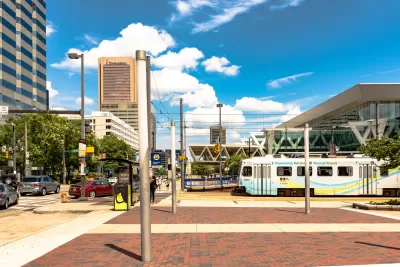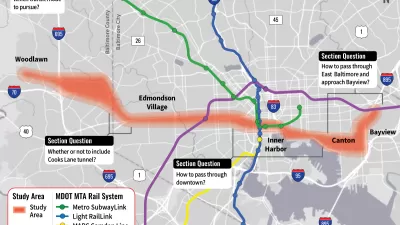The decision to go with light rail over bus rapid transit will be more expensive and take longer to complete, but proponents say it’s an investment in Baltimore’s economic future.

According to a Patch article by Megan VerHeist, Baltimore’s revived Red Line project will be a light rail system rather than bus rapid transit. Maryland Gov. Wes Moore made the announcement, which VerHeist reports “delivers on a key campaign promise made by Moore to revive the project canceled by former Gov. Larry Hogan.” The 14-mile, 19-station Red Line project will fill a gap in east-west transit service and link high-poverty neighborhoods along the proposed route to two key job hubs. It will be the first expansion of the city’s transit network in decades.
Critics of the project, including the former Gov. Hogan, who canceled the project in 2015, say it’s a waste of money. State officials estimate it will cost $3.2 to $7.2 billion to construct, and it will be years before they’ll be ready to break ground. The announcement also comes as “the state faces a major shortfall of transportation funding over the next five years, driven in part by the need to meet its obligations to Washington’s Metro system and to pay for the coming Purple Line in the D.C. suburbs,” an article in the Baltimore Banner reports.
FULL STORY: Light Rail Chosen Over Buses For Baltimore's Red Line Transit Project

Planetizen Federal Action Tracker
A weekly monitor of how Trump’s orders and actions are impacting planners and planning in America.

Congressman Proposes Bill to Rename DC Metro “Trump Train”
The Make Autorail Great Again Act would withhold federal funding to the system until the Washington Metropolitan Area Transit Authority (WMATA), rebrands as the Washington Metropolitan Authority for Greater Access (WMAGA).

The Simple Legislative Tool Transforming Vacant Downtowns
In California, Michigan and Georgia, an easy win is bringing dollars — and delight — back to city centers.

In These Cities, Most New Housing is Under 441 Square Feet
With loosened restrictions on “micro-housing,” tiny units now make up as much as 66% of newly constructed housing.

Albuquerque’s Microtransit: A Planner’s Answer to Food Access Gaps
New microtransit vans in Albuquerque aim to close food access gaps by linking low-income areas to grocery stores, cutting travel times by 30 percent and offering planners a scalable model for equity-focused transit.

This City Will Pay You to Meet Your Neighbors
A North Kansas City grant program offers up to $400 for residents to throw neighborhood block parties.
Urban Design for Planners 1: Software Tools
This six-course series explores essential urban design concepts using open source software and equips planners with the tools they need to participate fully in the urban design process.
Planning for Universal Design
Learn the tools for implementing Universal Design in planning regulations.
Smith Gee Studio
City of Charlotte
City of Camden Redevelopment Agency
City of Astoria
Transportation Research & Education Center (TREC) at Portland State University
US High Speed Rail Association
City of Camden Redevelopment Agency
Municipality of Princeton (NJ)




























